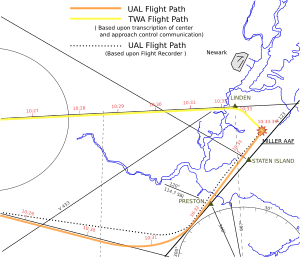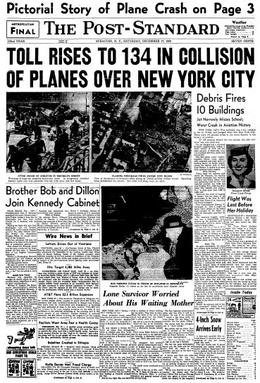1960 New York mid-air collision facts for kids
| Accident summary | |
|---|---|
| Date | December 16, 1960 |
| Summary | Mid-air collision |
| Place | About a mile west of Miller Field 40°34′07″N 74°07′19″W / 40.56861°N 74.12194°W |
| Total injuries (non-fatal) | 0 |
| Total fatalities | 134 |
| Total survivors | 0 |
| First aircraft | |
 The tail assembly of N8013U, the Douglas DC-8-11 involved in the collision |
|
| Type | Douglas DC-8-11 |
| Name | Mainliner Will Rogers |
| Airline/user | United Airlines |
| Registration | N8013U |
| Flew from | Chicago-O'Hare International Airport (ORD/KORD), IL |
| Flying to | Idlewild Airport (IDL/KIDL)(Now John F. Kennedy International Airport), New York City |
| Passengers | 77 |
| Crew | 7 |
| Injuries (non-fatal) | 0 (1 initially) |
| Fatalities | 84 (83 initially) |
| Survivors | 0 (1 initially) |
| Second aircraft | |
N6907C, the Lockheed L-1049A Super Constellation involved. |
|
| Type | Lockheed L-1049A Super Constellation |
| Name | Star of Sicily |
| Airline/user | Trans World Airlines |
| Registration | N6907C |
| Flew from | Dayton International Airport (DAY/KDAY), Dayton, Ohio |
| Stopover | Port Columbus International Airport (CMH/KCMH), Ohio |
| Flying to | LaGuardia Airport KLGA New York |
| Passengers | 39 |
| Crew | 5 |
| Fatalities | 44 |
| Survivors | 0 |
On Friday, December 16, 1960, a United Airlines Douglas DC-8 bound for Idlewild Airport (now John F. Kennedy International Airport) in New York City collided in midair with a TWA Lockheed L-1049 Super Constellation descending toward LaGuardia Airport. The Constellation crashed on Miller Field in Staten Island and the DC-8 in Park Slope, Brooklyn, killing all 128 aboard the two aircraft and six people on the ground. The accident was the world's deadliest aviation disaster at the time.
The accident became known as the Park Slope plane crash or the Miller Field crash after the two crash sites. The accident was also the first hull loss and first fatal accident involving a Douglas DC-8.
Contents
Aircraft and crews
United Airlines Flight 826, Mainliner Will Rogers, registration N8013U was a DC-8-11 carrying 77 passengers and seven crewmembers from O'Hare International Airport in Chicago to Idlewild Airport (now John F. Kennedy International Airport) in Queens. The crew consisted of captain Robert Sawyer (age 46), first officer Robert Fiebing (40), flight engineer Richard Pruitt (30) and four stewardesses.
Trans World Airlines Flight 266, Star of Sicily, registration N6907C was a Super Constellation carrying 39 passengers and five crew members from Dayton and Columbus, Ohio, to LaGuardia Airport in Queens. The crew consisted of captain David Wollam (age 39), first officer Dean Bowen (32), flight engineer LeRoy Rosenthal (30) and two stewardesses. Star of Sicily's sister ship N6902C, Star of the Seine, was destroyed in another mid-air collision with a United Airlines flight in 1956.
Background
At 10:21 a.m. Eastern Time, United 826 advised ARINC radio that one of its VOR receivers was inoperative, and the message was relayed to United Airlines maintenance. However, air-traffic control (ATC) was not informed that the aircraft had only one operational receiver, which presented difficulty for the pilots of flight 826 to identify the Preston intersection, beyond which it had not received clearance.
At 10:25 a.m., ATC issued a revised clearance for the flight to shorten its route to the Preston holding point (near Laurence Harbor, New Jersey) by 12 miles (19 km). That clearance included holding instructions (a standard "racetrack" holding pattern) for Flight 826 when it arrived at the Preston intersection. Flight 826 was expected to reduce its speed before reaching Preston to a standard holding speed of 210 knots (240 mph; 390 km/h) or lower. However, the aircraft was estimated to be traveling at 301 knots (346 mph; 557 km/h) when it collided with the TWA plane, several miles beyond the Preston clearance limit.
During the investigation, United Airlines claimed that the Colts Neck VOR was unreliable. Preston was the point where airway V123—the 050-radial off the Robbinsville VOR—crossed the Solberg 120-degree radial and the Colts Neck 346-degree radial. However, the Civil Aeronautics Board's final report found no problem with the Colts Neck VOR.
The prevailing conditions were light rain and fog, which had been preceded by snowfall.
Collision and ground impacts
According to the DC-8's flight data recorder, the aircraft was 12 miles (19 km) off course, and for 81 seconds it descended at 3,600 feet per minute (18 m/s) while slowing from more than 400 knots (460 mph; 740 km/h) to 301 knots (346 mph; 557 km/h) at the time of the collision.
One of the DC-8's starboard engines struck the Constellation just ahead of its wings, tearing apart a portion of the fuselage. The Constellation entered a dive, with debris continuing to fall as it disintegrated during its spiral to the ground.
The initial impact tore the DC-8's engine from its pylon. Having lost one engine and a large part of the right wing, the DC-8 remained airborne for another 90 seconds.
The DC-8 crashed into the Park Slope section of Brooklyn at the intersection of Seventh Avenue and Sterling Place (40°40′38″N 73°58′25″W / 40.67709°N 73.97368°W), scattering wreckage and setting fire to ten brownstone apartment buildings, the Pillar of Fire Church, the McCaddin Funeral Home, a Chinese laundry and a delicatessen. Six people on the ground were killed.
The crash left the remains of the DC-8 pointed southeast toward a large open field at Prospect Park, blocks from its crash site. An occupant in one of the affected apartment buildings said that his family survived because they were in the only room of their apartment that was not destroyed. The crash left a trench covering most of the length of the middle of Sterling Place. Witnesses thought that a bomb had detonated or that a building's boiler had exploded.
The TWA plane crashed onto the northwest corner of Miller Field at 40°34′12″N 74°06′11″W / 40.57°N 74.103°W, with some sections of the aircraft landing in New York Harbor. At least one passenger fell into a tree before the wreckage hit the ground.
There was no radio contact with traffic controllers from either plane after the collision, although LaGuardia had begun tracking an incoming, fast-moving, unidentified plane from Preston toward the LaGuardia "Flatbush" outer marker.
Investigation
The likely cause of the accident was identified in a report by the US Civil Aeronautics Board:
United Flight 826 proceeded beyond its clearance limit and the confines of the airspace allocated to the flight by Air Traffic Control. A contributing factor was the high speed of the United DC-8 as it approached the Preston intersection, coupled with the change of clearance which reduced the en-route distance along Victor 123 by approximately 11 miles (9.6 nmi; 18 km).
Initial survivor
The only person to initially survive the crash was Stephen Baltz, an 11-year-old boy from Wilmette, Illinois. He was traveling unaccompanied on Flight 826 to spend Christmas in Yonkers with relatives. He was thrown from the plane into a snowbank, where his burning clothing was extinguished. Although alive and conscious, he was severely burned and had inhaled burning fuel. Baltz died of pneumonia the next day.
Legacy
The total of 134 victims would not be surpassed until a Lockheed C-130B Hercules was shot down in May 1968, killing 155 people. In terms of commercial aviation, the death toll would not be surpassed until the March 1969 crash of Viasa Flight 742, which crashed on takeoff and killed all 84 people on board the aircraft, as well as 71 people on the ground.
In 2010, on the 50th anniversary of the accident, a memorial to the 134 victims of the two crashes was unveiled in Green-Wood Cemetery, Brooklyn. The cemetery is the site of the common grave containing the remains of those whom could not be identified.
The collision is covered in "Collision Course," the fifth episode of the first season of The Weather Channel documentary series Why Planes Crash.
See also
 In Spanish: Colisión aérea de Nueva York de 1960 para niños
In Spanish: Colisión aérea de Nueva York de 1960 para niños




